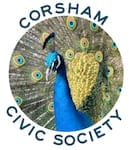The Priory, now known as Heywood House School, in Priory Street
The town once belonged to the kings of the day, and was therefore known as a Royal Manor. Surrounded by forests, the Saxon kings came here to hunt deer. Corsham is recorded as having a great ‘Palace’, and it was here that Ethelred the Unready became ill, and had to return to London in 1015.
But there was another parcel of land, which belonged to the church and was known as the ‘Rectory Manor’. When William the Conqueror came to the throne, he rewarded many of his followers with land and privileges. Here he gave Corsham Church and its lands to his favourite Abbey, St Stephens at Caen, in Normandy. This was later transferred to the Abbey of Marmoutier. By 1240, the Royal Manor was in the hands of Richard Plantagenet, and it is reputed that whilst he was in residence at Corsham, the Monks of Marmoutier decided to cross the Channel to see what sort of property they had in this parish. They arrived, led by Prior Gilbert, and took up residence at the Priory. (Priory Street.) The house became the nearest thing to a monastery. The foundations of earlier buildings are known to be on the site, and the pond remains. It is significant that many monasteries had ponds where the brothers would breed fish for the table. However, the monks suddenly left the site, we know not when, perhaps because they did not like our weather!
Later occupation has been difficult to establish, and we leap forward to the period of the Dissolution of the Monasteries in the mid 16th century when we learn of one William Stump who bought the ruined Malmesbury Abbey for £1,516. 15s.2d. William was a clothier, and apparently filled the Abbey with looms. The link to Corsham? It was the descendant of this William, another clothier, who in 1750 erected the present building on this site and lived there for many years. The Street was then known as ‘Stump’s Lane’, and became Priory Street at the turn of the century. Sir Harold Brakspear came to the house in 1892, a young man, with his parents. In 1940 the Air Ministry requisitioned it, and members of the Women’s Royal Air Force were billeted there. The building was then later adapted to the school premises we know today.
One other interesting snippet of information – within the grounds of the Priory, adjacent to the street, is a low building, with a bell at the top. This building has severally acted as a morgue, a green grocers store, and a fire station. At the sound of the bell the volunteer firemen would down their tools and race to the site in order to catch the horse, fix it to the tender, and get to the blazing fire! Were they ever in time to avert catastrophe I wonder!
Isn’t it interesting to discover how many different lives some of the buildings in our town have had?
Sources: This information is taken from a paper by Joe James, our late beloved local historian, dated 1999. He quoted his sources as – Anglo Saxon Chronicles, List of Buildings NWDC, W.A.M by Sir Harold Brakspear, White papers – Devizes Museum, Corsham Court publications, and Wilts Archives.
